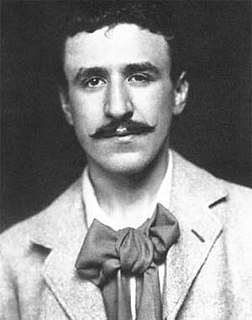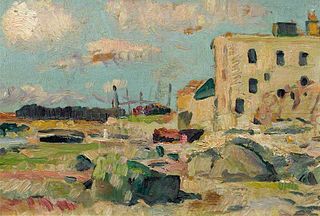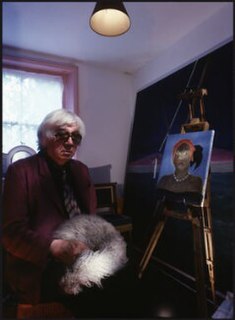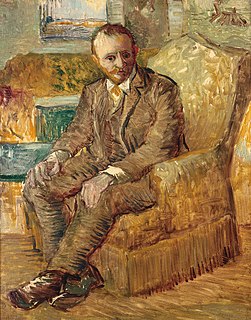Related Research Articles

Charles Rennie Mackintosh was a Scottish architect, designer, water colourist and artist. His artistic approach had much in common with European Symbolism. His work, alongside that of his wife Margaret Macdonald, was influential on European design movements such as Art Nouveau and Secessionism and praised by great modernists such as Josef Hoffmann. Mackintosh was born in Glasgow and died in London. He is among the most important figures of Modern Style.

The Scottish Colourists were a group of four painters, three from Edinburgh, whose Post-Impressionist work, though not universally recognized initially, came to have a formative influence on contemporary Scottish art and culture. They were Francis Cadell, John Duncan Fergusson, Leslie Hunter and Samuel Peploe.
The Glasgow School was a circle of influential artists and designers that began to coalesce in Glasgow, Scotland in the 1870s, and flourished from the 1890s to around 1910. Representative groups included The Four, the Glasgow Girls and the Glasgow Boys. Part of the international Art Nouveau movement, they were responsible for creating the distinctive Glasgow Style.

John Pettie was a painter from Edinburgh who spent most of his career in London. He became a member of the Royal Academy in 1866 and a full academician in 1874.

Dame Elizabeth Violet Blackadder, Mrs Houston, was a Scottish painter and printmaker. She was the first woman to be elected to both the Royal Scottish Academy and the Royal Academy.

John Duncan Fergusson was a Scottish artist and sculptor, regarded as one of the major artists of the Scottish Colourists school of painting.

Horatio McCulloch, sometimes written MacCulloch or M'Culloch, was a Scottish landscape painter.

Samuel John Peploe was a Scottish Post-Impressionist painter, noted for his still life works and for being one of the group of four painters that became known as the Scottish Colourists. The other colourists were John Duncan Fergusson, Francis Cadell and Leslie Hunter.

George Leslie Hunter was a Scottish painter, regarded as one of the four artists of the Scottish Colourists group of painters. Christened simply George Hunter, he adopted the name Leslie in San Francisco, and Leslie Hunter became his professional name. Showing an aptitude for drawing at an early age, he was largely self-taught, receiving only elementary painting lessons from a family acquaintance. He spent fifteen formative years from the age of fifteen in the US, mainly in California. He then returned to Scotland, painting and drawing there and in Paris. Subsequently, he travelled widely in Europe, especially in the South of France, but also in the Netherlands, the Pas de Calais and Italy.

Scottish art is the body of visual art made in what is now Scotland, or about Scottish subjects, since prehistoric times. It forms a distinctive tradition within European art, but the political union with England has led its partial subsumation in British art.

John Ronald Craigie Aitchison CBE RSA RA was a Scottish painter. He was best known for his many paintings of the Crucifixion, one of which hangs behind the altar in the chapter house of Liverpool Cathedral, Italian landscapes, and portraits. His simple style with bright, childlike colours defied description, and was compared to the Scottish Colourists, primitivists or naive artists, although Brian Sewell dismissed him as "a painter of too considered trifles".
The Fleming Collection is a large private collection of Scottish art. Originally a corporate collection dominating the walls of the Flemings bank, it had a home in a gallery on Berkeley Square, central London, England from 2002 until the gallery's closure in 2016. It now operates as a loaning and touring collection.
The Royal Glasgow Institute of the Fine Arts (RGI) is an independent organisation in Glasgow, founded in 1861, which promotes contemporary art and artists in Scotland. The Institute organizes the largest and most prestigious annual art exhibition in Scotland - open to all artists.

Scottish art in the nineteenth century is the body of visual art made in Scotland, by Scots, or about Scottish subjects. This period saw the increasing professionalisation and organisation of art in Scotland. Major institutions founded in this period included the Institution for the Encouragement of the Fine Arts in Scotland, the Royal Scottish Academy of Art, the National Gallery of Scotland, the Scottish National Portrait Gallery and the Glasgow Institute. Art education in Edinburgh focused on the Trustees Drawing Academy of Edinburgh. Glasgow School of Art was founded in 1845 and Grays School of Art in Aberdeen in 1885.

The New Scottish Group was a loose collection of artists based in Glasgow, who exhibited from 1942 to 1956. It was formed around John Duncan Fergusson after his return to Glasgow in 1939. It had its origins in the New Art Club formed in 1940, and had its first exhibition in 1942. Members did not have a common style, but shared left-wing views and were influenced by contemporary continental art. Members included Donald Bain, William Crosbie, Marie de Banzie and Isabel Babianska. Tom MacDonald, Bet Low and William Senior formed the Clyde Group to pursue political painting that manifested in urban industrial landscapes. The group helped start the careers of a generation of Glasgow-based artists and was part of a wider cultural "golden age" for the city.

Art in modern Scotland includes all aspects of the visual arts in the country since the beginning of the twentieth century. In the early twentieth century, the art scene was dominated by the work of the members of the Glasgow School known as the Four, led Charles Rennie Mackintosh, who gained an international reputation for their combination of Celtic revival, Art and Crafts and Art Nouveau. They were followed by the Scottish Colourists and the Edinburgh School. There was a growing interest in forms of Modernism, with William Johnstone helping to develop the concept of a Scottish Renaissance. In the post-war period, major artists, including John Bellany and Alexander Moffat, pursued a strand of "Scottish realism". Moffat's influence can be seen in the work of the "new Glasgow Boys" from the late twentieth century. In the twenty-first century Scotland has continued to produce influential artists such as Douglas Gordon and Susan Philipsz.

Landscape painting in Scotland includes all forms of painting of landscapes in Scotland since its origins in the sixteenth century to the present day. The earliest examples of Scottish landscape painting are in the tradition of Scottish house decoration that arose in the sixteenth century. Often said to be the earliest surviving painted landscape created in Scotland is a depiction by the Flemish artist Alexander Keirincx undertaken for Charles I.

Alexander Reid (1854–1928) was a Glasgow art dealer, and friend of James Abbott McNeill Whistler and Vincent van Gogh. He was one of the most influential art dealers in Europe in the early 20th century, exhibiting and selling artworks by some of the finest artists of his period, including the Impressionists, the Post-Impressionists, the Glasgow Boys and the Scottish Colourists. He helped build up the French painting collection of Sir William Burrell. and many of the works he dealt with now feature in major private, civic and national art collections all over the world.

Elizabeth "Bessie" MacNicol (1869–1904) was a Scottish painter and member of the Glasgow Girls group of artists affiliated with the Glasgow School of artists.

Adam Bruce Thomson OBE, RSA, PRSW or ‘Adam B’ as he was often called at Edinburgh College of Art, was a painter perhaps best known for his oil and water colour landscape paintings, particularly of the Highlands and Edinburgh. He is regarded as one of the Edinburgh School of artists.
References
- ↑ "Hamish MacDonald". The Scotsman, 21 September 2008
- ↑ "U.K.: Hamish MacDonald, artist whose diagnosis 'opened new doors' dies, 73". Seniors World Chronicle. 17 September 2008. Archived from the original on 1 September 2014. Retrieved 10 September 2015.
- ↑ 7 artworks by or after Hamish MacDonald , Art UK . Retrieved 10 September 2015.
- ↑ "Everything in the Garden is lovely", Clare Henry, The Glasgow Herald - 31 March 1989